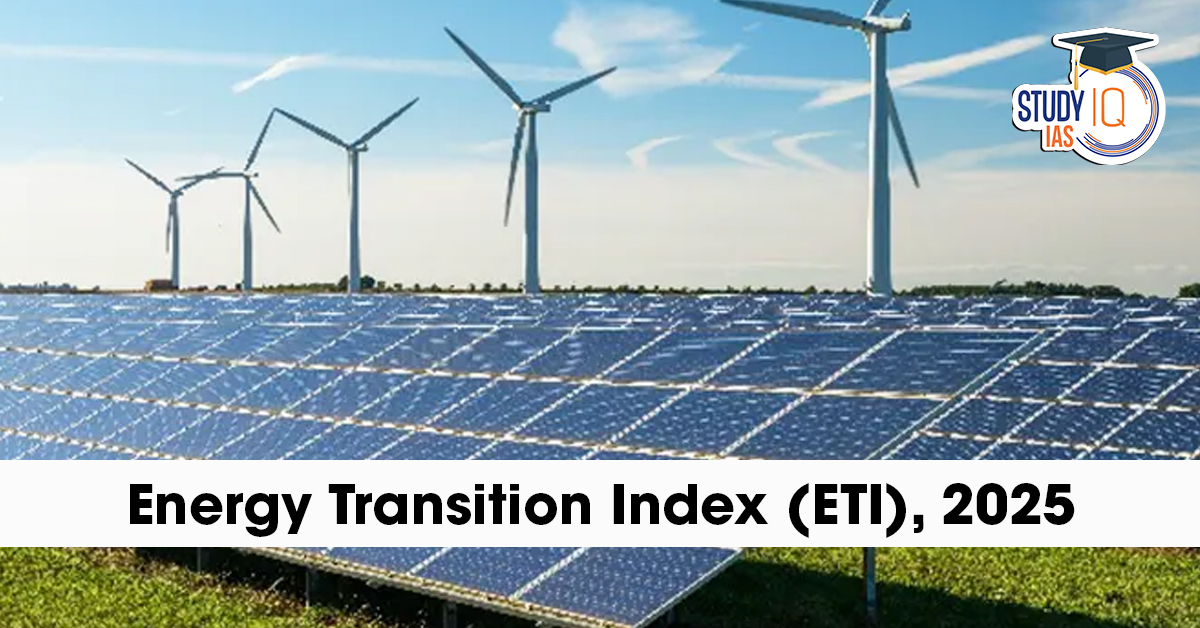Table of Contents
Context: Recently, the Energy Transition Index (ETI) was released by the World Economic Forum.
Energy Transition Index 2025: Key Highlights
Top 5 Countries
- Sweden
- Finland
- Denmark
- Norway
- Switzerland
Other top 10 countries include Austria, Latvia, the Netherlands, Germany, and Portugal.
Other Major Rankings
- China: 12th
- Brazil: 15th
- USA: 17th
- Pakistan: 101st
- Congo: Ranked lowest
India’s Performance in ETI 2025
- Rank: India fell to 71st rank among 118 countries in the ETI 2025, eight positions lower than its 63rd rank in 2024.
- Score: India’s overall ETI score is 53.3, system performance score being 60.4 and transition readiness score being 42.7.
Strengths (as identified by the report)
- Energy efficiency: Reduced energy intensity and methane emissions.
- Investment capacity: Enhanced regulatory environment and financial investments, specifically in clean and renewable energy industries.
- Equity: Substantial progress in expanding access to energy and clean cooking fuels, particularly in rural districts, in the last ten years.
Challenges (Areas for Improvement)
- Transition Readiness: India’s score here is well below leaders, reflecting systemic issues that may hold back long-term scalability and resilience.
- Reliance on foreign fuels.
- Infrastructure bottlenecks: Including delays in permits, labour shortages, and grid capacity, most notably for adding renewables.
- Grid flexibility and supply diversification.
- Clean energy deployment beyond the power sector.
About Energy Transition Index (ETI) 2025
The Energy Transition Index (ETI) 2025 is an all-encompassing benchmarking report published by the World Economic Forum (WEF) and Accenture. The index measures the performance of the energy systems in 118 nations against their achievement towards a secure, sustainable, and equitable energy transition. The “Fostering Effective Energy Transition 2025” report featuring the ETI was issued on June 18, 2025.
- Purpose: Assesses national energy systems and tracks progress in energy transition across 118 countries
- Final Score: Composite of two sub-indices:
- System Performance (60%) – Measures equity, security, and sustainability
- Transition Readiness (40%) – Includes:
- Core Enablers: Regulation, political commitment, finance & investment
- Enabling Factors: Innovation, infrastructure, education, and human capital
How ETI is Calculated
The ETI evaluates nations on two broad areas, using 43 indicators and rating nations from 0 to 100:
System Performance (60%)
Evaluates the performance of a nation’s existing energy system on three equally important priorities:
- Energy Security: Reliable and robust energy supply, source diversity, grid reliability.
- Energy Equity: Access to low-cost energy for all consumers and industries.
- Environmental Sustainability: Encouraging lower-carbon energy sources and lowering emissions.
Transition Readiness (40% weighting)
Examines the transition enabling environment, comprising five components:
- Political Commitment: Policy and regulatory support.
- Finance and Investment: Access to finance for clean energy projects.
- Innovation: R&D and deployment of new energy technologies.
- Infrastructure: Grid capacity, smart meters, and other enabling structures.
- Human Capital: Skills and public knowledge.
Challenges
The report points out that geopolitical fragmentation, inflation, and pressure on digital infrastructure (such as from AI-powered data centers) would spoil future gains if left unchecked. There is a large disconnect between capital flows and future energy demand, with more than 80% of energy demand growth being in emerging and developing economies and more than 90% of clean energy investment being in advanced economies and China.


 Why India Need Bioremediation? Types, Go...
Why India Need Bioremediation? Types, Go...
 Khiamniungan Tribe: Nagaland’s Trans-B...
Khiamniungan Tribe: Nagaland’s Trans-B...
 Kashi Tamil Sangamam 4.0 (2025): Dates, ...
Kashi Tamil Sangamam 4.0 (2025): Dates, ...

























